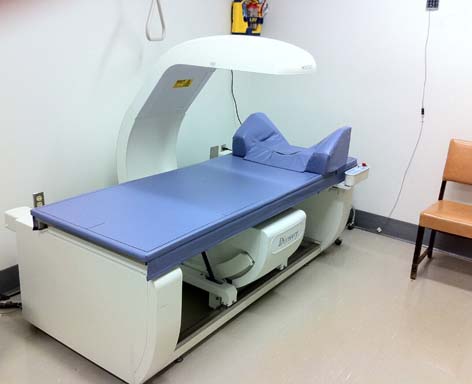Musculoskeletal
Assessment
Dual-energy X-ray absorptiometry (DXA):
DXA is the most widely used clinical method of measuring bone mineral density (BMD).
Method:
- An array of two X-ray beams of different energies is used to scan the patient.
- An image is reconstructed and proprietary analysis algorithms calculate BMD based on the differential X-ray absorption of bone versus soft tissue.
Bone mineral density measured by this technique is not a true physical density. Instead, the artificial quantity of 'areal density' is obtained which has units of grams per square centimeter, reflecting the two dimensional nature of the image which is acquired.
The BMD scanner software contains normative databases which are used to calculate each patient's BMD in terms standard deviation away from the mean. The normative database used for a particular patient depends on the demographic of that patient. For example, the BMD of a post-menopausal female is compared to a normative database of young females. For such a patient, a BMD measurement which is equal to or more than 2.5 standard deviations below the mean constitutes a diagnosis of osteoporosis according to World Health Organization criteria.
For children, BMD measurement is compared to an age- and gender-matched normative database. A child with a BMD more than two standard deviations below the mean for his or her age is said to have 'low bone mass'.
In post-menopausal females and males aged fifty years or older, there is a strong statistical association between bone mineral density and risk of fracture which may be used to guide treatment, including the use of anti-resorptive medications which inhibit the process of bone breakdown.
BMD measurement is quick, painless, non-invasive and involves minimal radiation exposure. Measurements are most commonly made over the lumbar spine and over the hip. However, since a whole body image is usually acquired in addition, the analysis software can also provide information on soft tissue composition, for example, total body fat and lean muscle mass.
The Hologic Discovery Dual Energy X-ray Absorptiometry Scanner for measuring BMD:

Visit the following links:
Dual-energy X-ray absorptiometry at Wikipedia
Interactive tutorial by Stephen J. Pintauro, Ph.D: DEXA Interactive Tutorial web page

